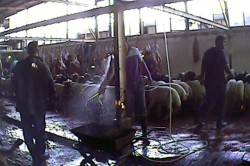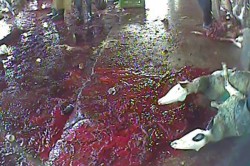Compassion in World Farming visited Beirut Public Slaughterhouse in Karantina in Lebanon in October 2013. The handling of animals was very poor. Two cattle were hauled into the slaughter area using ropes. Workers attempted to pull the two bulls through a space wide enough for only one. The bulls resisted and as a result baulked, slipped and fell. They fell hard with the weight of their body to their knees and hit their face on the concrete. Their legs became temporarily trapped in between the bars of the walk way and in the gutters. The staff shouted and yelled at the animals and hit and prodded them with what appeared to be metal bars. When the animals eventually reached the slaughter area they slipped and fell, clearly panicked.
Sheep were dragged by their rear legs, fleeces and horns. Some were carried on the shoulders of the slaughterhouse workers. Once at the place of slaughter, they were turned over and then roughly dropped or thrown onto their backs or sides in readiness for throat cutting.
A large flock of sheep was led from one side of the slaughter area to the other. They had to jump over the body of a half-skinned cow and cross large gutters filled with blood and other waste. Many of the sheep slipped, tripped or fell and many hesitated upon crossing the gutters. When the flock had arrived at their destination area, the sheep were dragged one at a time, from the flock to the slaughter point. As the line of slaughtered sheep got longer, the sheep had to be pulled further from the flock of waiting sheep; they were dragged on their knees by the back leg to the end of the line of slaughtered sheep. Some sheep slipped and hit their face and/or chest on the concrete. The waiting sheep were visibly fearful and pushed against the rest of the flock in an attempt to get away from the slaughtermen.
While awaiting slaughter sheep were able to see other sheep being slaughtered and bleeding out. Sheep were often restrained with a worker’s foot being placed against the chest or neck both prior and post cutting of the throat. Some cuts were not made swiftly in one single motion. On some occasions the slaughtermen wiped the bloodied knife on the face or fleece of the sheep before they lost consciousness.
It appears that all cattle in this slaughterhouse are hoisted by one rear leg before slaughter; the leg is chained to an overhead rail. This is a distressing and painful position for the animals. Two cattle were hoisted by a rear leg and left suspended and conscious for the entire duration of our investigators’ visit; over one hour. No attempt was made to alleviate their suffering. One of the animals repeatedly tried to right itself; it had a serious injury to its head which bled profusely.





